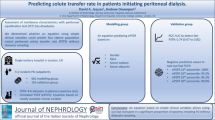Abstract
In the peritoneal dialysis, it is well-known that the peritoneal permeability increases gradually over the duration of treatment. The enhancement of the peritoneal permeability causes an under-dialysis and ultrafiltration failure, which is one of the grave factors which disrupt the homeostasis of body fluid. Hence, the monitoring of the peritoneal permeability is very important in order to give each patient some better prescriptions. In this study, we designed a novel criterion which can evaluate quantitatively the peritoneal permeability by applying a kinetic model for the peritoneal dialysis. Moreover clinical implementations of the novel criterion were validated with using the clinical data. By employing PD NAVI (JMS Co.,Ltd., Hiroshima, Japan), 50 well-being peritoneal dialysis patients performed the peritoneal function test including the peritoneal equilibration test (PET), which measured both urea and creatinine concentrations in the dialysate and drainage volumes. The overall mass transfer area coefficient for urea (MTACu) and that for creatinine (MTACc) were determined from a peritoneal mass transfer model and the clinical data for each patient. An average of MTACu/c which is the ratio of MTACu to MTACc was 1.78 and a standard deviation of that was 0.32. MTACu/c correlated with the drainage volume of PET (r2>0.66). Moreover a decrease of MTACu/c showed the enhancement of the peritoneal permeability (p<0.0001). Furthermore, since MTACu/c implies a peritoneal diffusive selectivity, MTACu/c also correlated with dialysis outcomes such as Kt/V for urea and weekly creatinine clearance normalized to 1.73m2. Then, we could derive some recommendations for MTACu/c by applying the recommendations for the dialysis outcomes such as NKF-DOQI guideline. Thus, MTACu/c can evaluate not only the peritoneal permeability, but also the dialysis outcome. We proposed that MTACu/c is available as the criterion which manages the peritoneal permeability and the therapeutic efficiency of the peritoneal dialysis.
Access this chapter
Tax calculation will be finalised at checkout
Purchases are for personal use only
Preview
Unable to display preview. Download preview PDF.
Similar content being viewed by others
References
Twardowski Z, Nolph, KD. Khanna R et al. (1987) Peritoneal equilibration test. Perit Dial Bul 7:138–147
CANADA-USA (CANUSA) PERITONEAL DIALYSIS STUDY GROUP (1996) Canada-USA(CANUSA) study of peritoneal dialysis adequacy. Adequacy of dialysis and nutrition in continuous peritoneal dialysis: Association with clinical outcomes. J Am Soc Nephrol. 7:198–207
National Kidney Foundation (1997) NKF-DOQI ADVISORY COUNCIL. Am J Kidney Dis 30:S69–S136
National Kidney Foundation (2001) NKF-K/DOQI CLINICAL PRACTICE GUIDELINES FOR PERITOENAL DIALYSIS ADEQUACY: UPDATE 2000. Am J Kidney Dis 37:S65–S136
Edwina AB, Simon JD, Peter R et al. (2003) Survival of functionally an uric patients on automated peritoneal dialysis: The European APD Outcome Study. J Am Soc Nephrol 14:2948–2957
Yamashita AC, Ishizaki M, Nakamoto M et al. (2003) Re-evaluation of adequate dose in Japanese PD patients. Adv Perit Dial 19:103–105
Ishizaki M, Yamashita AC, Kawanishi H et al. (2004) Dialysis dose and nutrition in Japanese peritoneal dialysis patients. Adv Perit Dial 20:141–143
Hamada H, Namoto S, Yamada R et al. (2005) Development of a Computer aided diagnosis system for a new modality of the renal replacement therapy — An integrated approach combining both peritoneal dialysis and hemodialysis. Comput Biol Med 35:845–861
Henderson LW. (1969) Altered permeability of the peritoneal membrane after using hypertonic peritoneal dialysis fluid. J Clin Invest 48:992–1001
Babb AL, Johansen PJ, Strand MJ et al. (1973) Bi-directional permeability of the human peritoneum to middle molecules. Proc Eur Dial Transplant Assoc 10:247–262
Garred LJ, Canand B., Farrell PC (1983) A simple kinetic model for assessing peritoneal dialysis. ASAIO J 6:131–137
Yamashita AC, Hamada H (1998) New Simple Mathematical Model for Evaluation of Peritoneal Permeability, Japanese. J Jpn Soc Dial Ther 31:183–9
Hume R, Weyers E (1971) Relationship between total body water and surface area in normal and obese subjects. J Clin Path 24:234–238
Gehan E, George S (1970) Estimattions of human body surface area from height and weight. Cancer Chemother Rep 54:225–235
Ohta K, Ishizaki M, Sanaka M et al. (1999) Report of clinical data for Japanese CAPD patients, Japanese. Fukumakutouseki 99:383–391
Villarroel F, Popovich RP, Nolph KD (1978) Evaluation of permeance in peritoneal dialysis. J Dial 2:361–378
Author information
Authors and Affiliations
Corresponding author
Editor information
Rights and permissions
Copyright information
© 2007 International Federation for Medical and Biological Engineering
About this paper
Cite this paper
Hamada, H. et al. (2007). Availability of a Novel Criterion for Peritoneal Diffusive Selectivity on Peritoneal Dialysis. In: Magjarevic, R., Nagel, J.H. (eds) World Congress on Medical Physics and Biomedical Engineering 2006. IFMBE Proceedings, vol 14. Springer, Berlin, Heidelberg. https://doi.org/10.1007/978-3-540-36841-0_809
Download citation
DOI: https://doi.org/10.1007/978-3-540-36841-0_809
Publisher Name: Springer, Berlin, Heidelberg
Print ISBN: 978-3-540-36839-7
Online ISBN: 978-3-540-36841-0
eBook Packages: EngineeringEngineering (R0)




